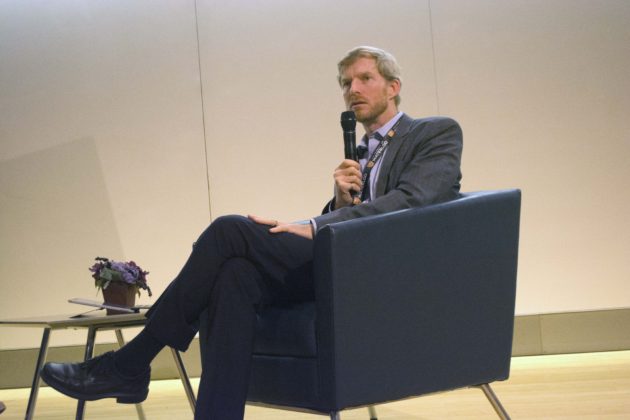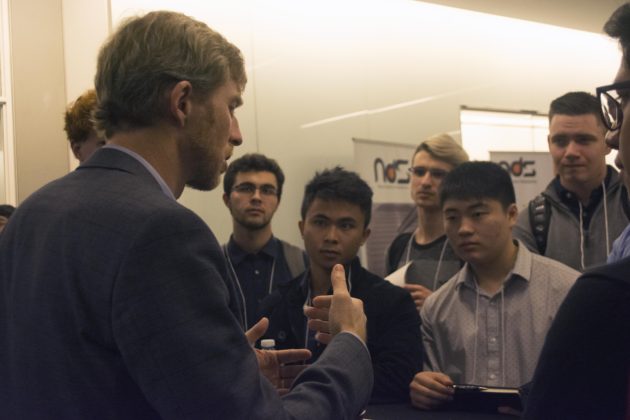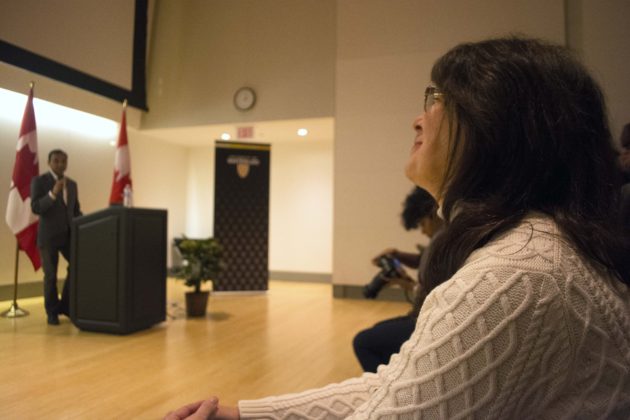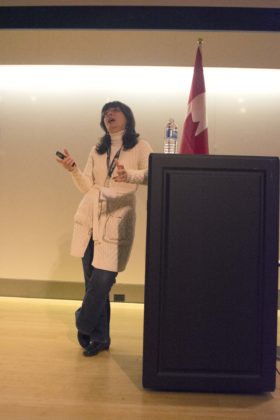Nov. 18 marked a big day for small science — the third annual nanotechnology conference.
“Whatever your age is, whatever your discipline is, there is something here for you to learn,” said conference co-chair Jatin Patil, himself a 4A student of nanotechnology.
Certainly, plenty had arrived to do just that; Nov. 18 saw the QNC filled with undergraduates, industry experts, and professionals alike gathered to discuss the rise and possibilities in the field of nanotechnology.
Included amongst the group was the honourable Bardish Chagger, Waterloo MP and minister of small business and tourism, who spoke on the federal government’s support of student endeavours.
Continuing the theme of government-driven efforts in innovation, Dr. Duncan Stewart — general manager for security and disruptive technologies at the National Research Council of Canada — spoke on the role of policy in Canadian STEM fields. In particular, Stewart highlighted the role of the Canadian government in tackling global issues which may not be feasible for the private sector.
“There’s no one that will pay you to clean up the air of your neighbourhood,” he said.
For this reason, said Stewart, while the science of the NRC has seen remarkable evolution over past years, one key aspect of the council has remained constant.
“The purpose of the organization has not changed,” he said. “It’s to solve public problems for Canada.”
Some examples which Stewart highlighted for the audience included drought-resistant wheat crops, development of nanomaterials for printable electronics, and measures to improve quantum computing.
To demonstrate the complementary role of the private sector, the conference then welcomed a panel of industry experts for discussion on the real-world applications of nanotechnology.
This year’s panel featured a wide range of industry specialists including Armin Fischer, COO and lead chemist of QD Solar Inc.; Rina Carlini, CEO and president of Haltech; Melanie Ledgerwood, research and development manager at Teledyne Dalsa; and Dan Sinai, senior executive of innovation at IBM Canada.
With an extensive background in research and commercialization of nanotechnology-based products, in his current position with QD Solar Inc., nanotechnology is at the forefront of Fischers’ work.
“Our product is a solar cell that absorbs light and infrared and our core technology is truly…quantum dots,” he said. “Nanomaterials also means huge challenges [in] the reproducibility [and] repeatability of processes.”
After years of experience in pharmaceutical drug discovery research and extensive work alongside Xerox, Carlini now works to mentor startups via Haltech, one of 18 Ontario regional innovation centres.
“Nanotechnology is a very powerful enabling technology,” she said. “If it helps you get to the kind of scale size and feature performance that … will help your company win in the marketplace, that’s a good thing to use.”
A graduate of applied physics from the University of Waterloo, Ledgerwood was one of many students who benefitted from co-op. This continues to be the main intersection between Teledyne Dalsa and nanotechnology, said Ledgerwood, expressing her hope that new revolutions in imaging technology would stem from the research of the audience.
“So get to it and then we’ll make it into a product later,” she joked.
After graduating from the University of Waterloo, Sinai went on to complete a wide range of research administration roles and in his current position at IBM, strives to enrich Canadian entrepreneurial ecosystems.
“You have to remember, we’re a data company,” he said of IBM. “For me, nano mean those sensors, those devices, those chips or whatever that … allow us to collect data in a very innovative way.”
After a combination lunch break and poster session, Dr. Joanna Aizenberg — chemistry and chemical biology professor at Harvard University — took to the stage for her keynote address.
Highly regarded in the field of biologically-inspired materials science, over the past nine years, she has hosted upwards of 40 UW co-op students at Harvard.
“From the moment I started to hire Waterloo students, I stopped hiring Harvard undergraduates,” she told the crowd. “They add diversity, multidisciplinarity, and they spend four to eight months in the labs seriously doing their research without [the] distraction of taking classes, and its [an] extremely powerful way to contribute to scientific projects.”
For Aizenberg, these projects have included a wide range of endeavours, each of which look to nature for inspiration in making materials which are “adaptive, responsive, and self-optimizing.”
The first of these, which she referred to as “sticky problems,” dealt with material coatings to create “slippery” surfaces. This technology, said Aizenberg, is counterintuitive because it uses roughness to capture lubricant and so create an ultra-smooth surface which shields the material from external factors.
Self-healing, resistant to temperature extremes, and impervious to outside contaminants, applications for the technology include medical imaging devices.
Aizenberg went on to highlight the processes of wicking, winking, and drinking, made possible by adding multiple layers of information into a material, after which it is able to adapt and react to the application of various substances.
She spoke also on the topic of dynamic materials, characterized by their reconfigurable nature and an appearance of hairiness. Technologies such as these, she said, can be applied to dynamic windows, for example, which adjust to changes in light and temperature.
By combining aspects of organisms which nature has already evolved, said Aizenberg, scientists can harness existing structures to problem solve with creativity.
“You don’t have to follow one organism for any good idea – combine these organisms,” she said.
In spite of the vast opportunities available to students of nanotechnology, Aizenberg had one simple hope for the audience, being “that each and every one of them would pursue the direction that they’re in love with.”
“It doesn’t matter what it is,” she told Imprint. “Follow your heart. Don’t go into something that is sexy and wonderful if you don’t like it.”





































